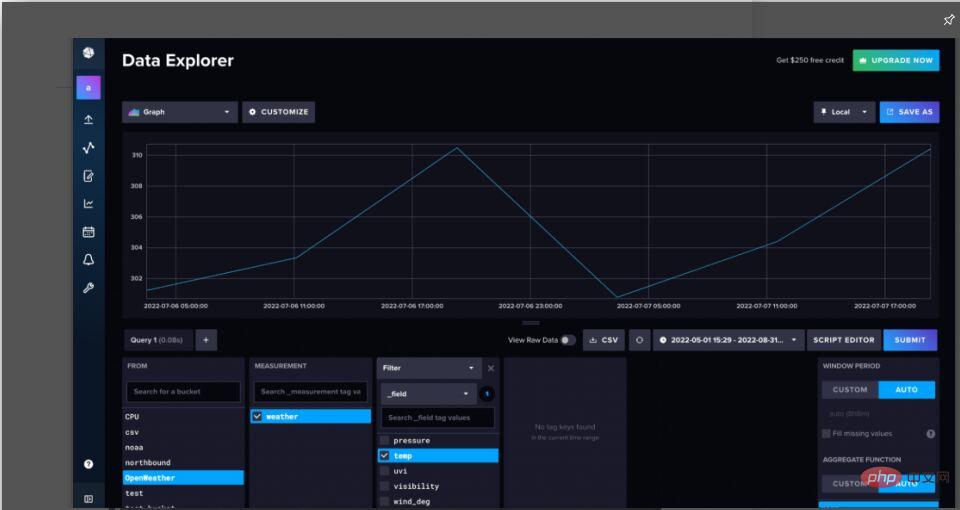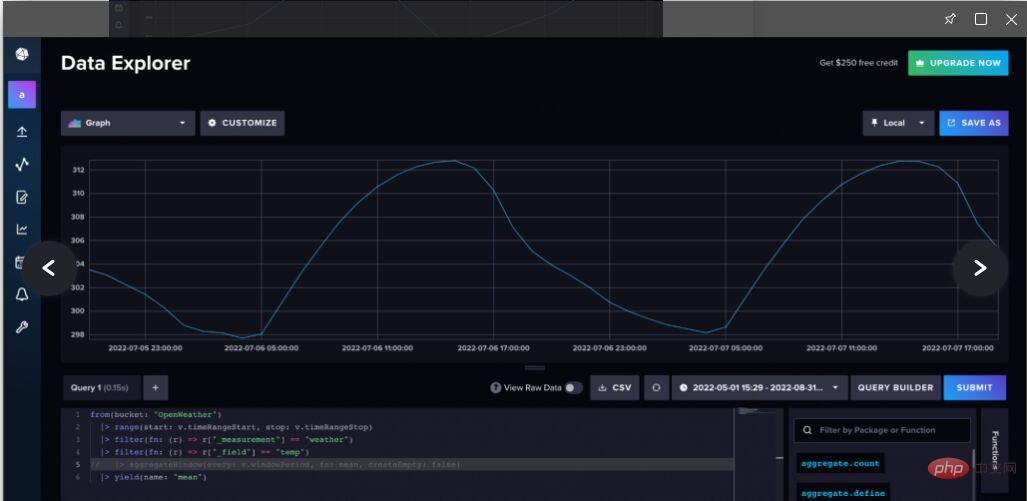

译者 | 布加迪
审校 | 孙淑娟
本教程将介绍如何使用Python从OpenWeatherMap API获取时间序列数据,并将其转换成Pandas DataFrame。接下来,我们将使用InfluxDB Python Client,将该数据写入到时间序列数据平台InfluxDB。
我们会将来自API调用的JSON响应转换成Pandas DataFrame,因为这是将数据写入到InfluxDB的最简单方法。由于InfluxDB是一个专门构建的数据库,我们写入到InfluxDB旨在满足时间序列数据在摄取方面的高要求。
本教程在通过Homebrew已安装Python 3的macOS系统上完成。建议安装额外的工具,比如virtualenv、pyenv或conda-env,以简化Python和Client的安装。完整的要求在这里:
txt influxdb-client=1.30.0 pandas=1.4.3 requests>=2.27.1
本教程还假设您已经创建Free Tier InfluxDB云帐户或正在使用InfluxDB OSS,您也已经:
最后,该教程要求您已经使用OpenWeatherMap创建了一个帐户,并已创建了令牌。
首先,我们需要请求数据。我们将使用请求库,通过OpenWeatherMap API从指定的经度和纬度返回每小时的天气数据。
# Get time series data from OpenWeatherMap API params = {'lat':openWeatherMap_lat, 'lon':openWeatherMap_lon, 'exclude': "minutely,daily", 'appid':openWeatherMap_token} r = requests.get(openWeather_url, params = params).json() hourly = r['hourly']
接下来,将JSON数据转换成Pandas DataFrame。我们还将时间戳从秒精度的Unix时间戳转换成日期时间对象。之所以进行这种转换,是由于InfluxDB写入方法要求时间戳为日期时间对象格式。接下来,我们将使用这种方法,将数据写入到InfluxDB。我们还删除了不想写入到InfluxDB的列。
python # Convert data to Pandas DataFrame and convert timestamp to datetime object df = pd.json_normalize(hourly) df = df.drop(columns=['weather', 'pop']) df['dt'] = pd.to_datetime(df['dt'], unit='s') print(df.head)
现在为InfluxDB Python客户端库创建实例,并将DataFrame写入到InfluxDB。我们指定了测量名称。测量含有存储桶中的数据。您可以将其视为InfluxDB的数据组织中仅次于存储桶的第二高层次结构。
您还可以使用data_frame__tag_columns参数指定将哪些列转换成标签。
由于我们没有将任何列指定为标签,我们的所有列都将转换成InfluxDB中的字段。标签用于写入有关您的时间序列数据的元数据,可用于更有效地查询数据子集。字段是您在 InfluxDB中存储实际时间序列数据的位置。该文档(https://docs.influxdata.com/influxdb/cloud/reference/key-concepts/?utm_source=vendor&utm_medium=referral&utm_campaign=2022-07_spnsr-ctn_obtaining-storing-ts-pything_tns)更详细地介绍了InfluxDB中的这些数据概念。
on # Write data to InfluxDB with InfluxDBClient(url=url, token=token, org=org) as client: df = df client.write_api(write_options=SYNCHRONOUS).write(bucket=bucket,record=df, data_frame_measurement_name="weather", data_frame_timestamp_column="dt")
回顾一下,不妨看看完整的脚本。 我们采取以下步骤:
1. 导入库。
2. 收集以下内容:
3. 创建请求。
4. 将JSON响应转换成Pandas DataFrame。
5. 删除您不想写入到InfluxDB的任何列。
6. 将时间戳列从Unix时间转换成Pandas日期时间对象。
7. 为InfluxDB Python Client库创建实例。
8. 编写DataFrame,并指定测量名称和时间戳列。
python import requests import influxdb_client import pandas as pd from influxdb_client import InfluxDBClient from influxdb_client.client.write_api import SYNCHRONOUS bucket = "OpenWeather" org = "" # or email you used to create your Free Tier InfluxDB Cloud account token = " url = "" # for example, https://us-west-2-1.aws.cloud2.influxdata.com/ openWeatherMap_token = "" openWeatherMap_lat = "33.44" openWeatherMap_lon = "-94.04" openWeather_url = "https://api.openweathermap.org/data/2.5/onecall" # Get time series data from OpenWeatherMap API params = {'lat':openWeatherMap_lat, 'lon':openWeatherMap_lon, 'exclude': "minutely,daily", 'appid':openWeatherMap_token} r = requests.get(openWeather_url, params = params).json() hourly = r['hourly'] # Convert data to Pandas DataFrame and convert timestamp to datetime object df = pd.json_normalize(hourly) df = df.drop(columns=['weather', 'pop']) df['dt'] = pd.to_datetime(df['dt'], unit='s') print(df.head) # Write data to InfluxDB with InfluxDBClient(url=url, token=token, org=org) as client: df = df client.write_api(write_options=SYNCHRONOUS).write(bucket=bucket,record=df, data_frame_measurement_name="weather", data_frame_timestamp_column="dt")
现在,我们已经将数据写入到InfluxDB,可以使用InfluxDB UI来查询数据了。导航到数据资源管理器(从左侧导航栏中)。使用Query Builder(查询构建器),选择想要可视化的数据和想要为之可视化的范围,然后点击“提交”。

图1. 天气数据的默认物化视图。InfluxDB自动聚合时间序列数据,这样新用户就不会意外查询太多数据而导致超时
专业提示:当您使用查询构建器查询数据时,InfluxDB自动对数据进行下采样。要查询原始数据,导航到Script Editor(脚本编辑器)以查看底层Flux查询。Flux是面向InfluxDB的原生查询和脚本语言,可用于使用您的时间序列数据来分析和创建预测。使用aggregateWindow()函数取消行注释或删除行,以查看原始数据。

图2. 导航到脚本编辑器,并取消注释或删除aggregateWindow()函数,以查看原始天气数据
但愿本文能帮助您充分利用InfluxDB Python Client库,获取时间序列数据并存储到InfluxDB中。如果您想进一步了解使用Python Client库从InfluxDB查询数据,建议您看看这篇文章(https://thenewstack.io/getting-started-with-python-and-influxdb/)。另外值得一提的是,您可以使用Flux从OpenWeatherMap API获取数据,并将其存储到InfluxDB。如果您使用InfluxDB Cloud,这意味着该Flux脚本将被托管和定期执行,因此您可以获得可靠的天气数据流,并馈入到实例中。想进一步了解如何使用Flux按用户定义的时间表获取天气数据,请阅读这篇文章(https://www.influxdata.com/blog/tldr-influxdb-tech-tips-handling-json-objects-mapping-arrays/?utm_source=vendor&utm_medium=referral&utm_campaign=2022-07_spnsr-ctn_obtaining-storing-ts-pything_tns)。
Ce qui précède est le contenu détaillé de. pour plus d'informations, suivez d'autres articles connexes sur le site Web de PHP en chinois!